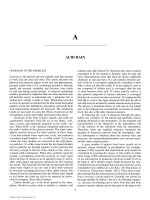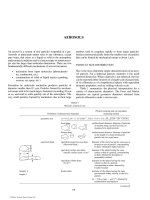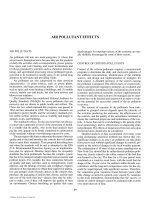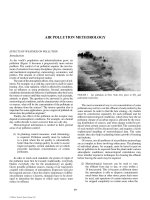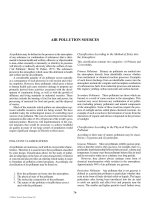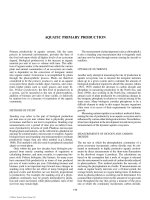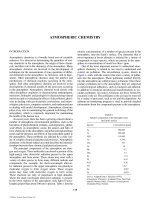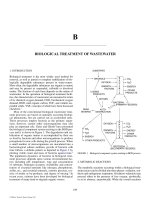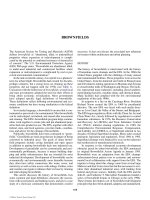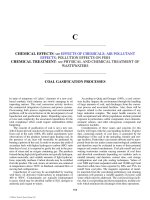ENCYCLOPEDIA OF ENVIRONMENTAL SCIENCE AND ENGINEERING - ELECTROSTATIC PRECIPITATION doc
Bạn đang xem bản rút gọn của tài liệu. Xem và tải ngay bản đầy đủ của tài liệu tại đây (324.5 KB, 13 trang )
282
ELECTROSTATIC PRECIPITATION
This article deals with high efficiency (99.5%) particu-
late removal techniques often required of modern central sta-
tion power plants. The reader is also referred to the article
“ Particulate Removal” for a discussion of control methods
including those used when more moderate conditions apply.
Electric power companies are required to analyze
proposals for, and subsequently to purchase, electrostatic
precipitators based on cost and performance.
The basic design factors which determine the collection
efficiency are the collecting plate area, the velocity of the gas,
the time that the gases are in contact with the discharge wires
and collecting plates, and the electrical system supplying the
useful power to the flue gas. It is the differences in these fac-
tors in the manufacturers’ proposals that give the engineer the
most trouble in choosing the precipitator that will continually
produce the required efficiency. The amount of useful power,
and therefore the collection efficiency, is primarily determined
by the number of active high tension electrical bus sections
into which the precipitator is divided (see Figure 1).
The collection efficiency of a precipitator is closely
related to the useful amount of electrical power than can
be supplied to the precipitator, the greater the useful power,
the higher the efficiency. If we imagine a precipitator with
all the discharge wires being supplied by one power source
through a single cable, the highest voltage that could be
maintained between the wires and the collecting plates
would be limited by the first wire to spark excessively. The
reason that one wire may spark excessively before another
is due to many factors including uneven distribution of the
gas and dust as they enter the precipitator, uneven build up
of ash on the wires and plates, mechanical misalignment of
the wires or plates and the fact that the collection process
produces a different amount of ash in the gas at the entrance
and discharge end of the precipitator. Even if all the wires
spark, at the same voltage, there is an appreciable loss in
efficiency due to lowered voltage in the wires operating in
parallel because the excessive sparks from one wire affect
all the others.
From this it is evident that the ideal precipitator would be
one in which each wire has its own stabilization control and
power source, but this, of course, would not be economically
feasible. Somewhere between these extremes is the practical
number of power sources or electrical bus sections that will
continually produce the desired efficiency.
Figure 1 shows the efficiency curve which may be used in
preparing specification and predicting actual operating efficiency.
This relationship between efficiency and active bus sections has
been referred to by White
2
as the “Ramsdell Equation.”
An active bus section refers to a separately energized
precipitator section where a transient electrical disturbance
in a given section is not reflected in any other section. This
condition exists when either one section is energized by
a single rectifier or when two sections are energized by a
double half wave rectifier.
A design criterion or an equation for the physical sizing of
precipitation is required. A curve based on Con Edison’s own
BUS SECTIONS PER 100,000 CMF
B
1
50
60
70
80
90
95
96
97
98
99
99.5
2345
COLLECTION EFFICIENCY, Ep, PERCENT
ELECTROSTATIC PRECIPITATOR
COLLECTION EFFICIENCY
Ep = 1–e
–RB
R = 1.3*
* CON EDISON
1.0% SULPHUR
300°F
FIGURE 1
© 2006 by Taylor & Francis Group, LLC
experience and that of other utilities is presented in Figure 2.
ELECTROSTATIC PRECIPITATION 283
The fundamental efficiency formula for an electrostatic
precipitator is
E = 1Ϫ e
Ϫw/30.48ϫAV
where
E = Collection Efficiency
A = Collection Area
V = Rate of Gas Flow
w = migration velocity, factor which is related to useful
electrical power
Low sulphur coal ash is not easy to collect with electrostatic
precipitators because of its high resistivity. This was inferred
from Figure 3 which shows by tests the effect of lowering
the sulphur in the coal on collection efficiency.
The Ramsdell Equation based on bus sections is a variation
of the fundamental formula and is expressed as
E = 1Ϫ e
ϪRB
where
E = Collection Efficiency
B = Number of active bus sections which is related to
useful electrical power
R = Performance Constant
Using tests data with medium and low sulphur coals and infor-
mation volunteered by other utilities for high sulphur coals, a
BUS SECTIONS PER 100,000 CFM
50
60
70
80
90
95
96
97
98
99
99.5
21
3.0 2.5 2.0
1.5
1.0
0.5
43567
COLLECTION EFFICIENCY PERCENT
BUS SECTIONS-EFFICIENCY
300°F
% S. IN COAL
FIGURE 4
12345
BUS SECTIONS PER 100,000 CFM
COLLECTION EFFICIENCY PERCENT
50
60
70
80
90
95
96
97
98
99
99.5
TEST 1965
2% S.
TEST 1967
1% S.
FIGURE 3
100
200
300
400
50
60
70
80
90
95
96
97
98
99
99.5
COLLECTING AREA PER 1000 CFM
SQUARE FEET
COLLECTION EFFICIENCY PERCENT
RAVENSWOOD 30
(600°F)
ASTORIA 30
ASTORIA 40,50
ARTHUR KILL 20
HUDSON AVE. 100
ASTORIA 10, 20
EAST RIVER 70
74
th
ST 120,121,122
FIGURE 2 Collecting efficiency vs Collecting area per 1000
CFM. Using this efficiency test data and precipitator collect-
ing area we were able to plot the equation or the dotted curve
shown in Figure 2.
© 2006 by Taylor & Francis Group, LLC
family of curves may be drawn (see Figures 4 and 5).
284 ELECTROSTATIC PRECIPITATION
0
90
95
96
97
98
99
99.5
99.6
99.7
99.8
99.9
3.0 2.0 1.5 1.2 1.1 1.0 0.9 0.8
0.7
0.6
0.5
0.4
99.95
99.96
99.97
99.98
100 200 300 400
500 600 700
800
900 1000 1100 1200
SQUARE FEET COLLECTING ELECTRODE PER 1000 CFM
SCA
300°F FLUE GAS TEMP.
EASTERN BITUMINOUS COAL
R.G.Ramsdell Jc
DEC. 16, 1980
STEAM FLOW, # PER HR.
COAL FIRED, # PER HR.
ASH, 12.5% # PER HR.
FLY ASH, # PER HR.
GAS FLOW, ACFM
AVG PRECIP.EFF %
EMISSION #/10
4
CTU
EMISSION GRAINS/CU FT
BOILER 20
BOILER 30
2,400,000
3,580,000
1,850,000
380,000
47,500
38,000
1,350,000
99.5
99.5
.033
.033
0.01
0.01
256,000
32,000
25,600
COLLECTION EFFICIENCY PERCENT
W
3048
X
EFFICIENCY=1–e
–
Precipitator Design Chart
DESIGN CRITERIA FOR ARTHUR KILL 20 & 30
PERCENT SULPHUR IN COAL*
CON
EDISON
A
V
FIGURE 5
© 2006 by Taylor & Francis Group, LLC
ELECTROSTATIC PRECIPITATION 285
There is another feature of precipitator design that is of
vital importance to collection efficiency, namely the velocity
of the ash laden gas flowing through the collector. The lower
the velocity, the greater treatment time available to thor-
oughly charge the flue gas and the lower the velocity, the less
chance there is for reentraining or sweeping off the fly ash
accumulated on the collecting plates. The lower the sulphur
content of the coal, the higher the resistivity of the ash. Since,
under these conditions the collected ash has difficulty stick-
ing to the collecting plates, lower sulphur coals require lower
gas velocity. Figure 6
indicates the maximum gas velocities
required to insure the required collection efficiencies when
burning 1.0% sulphur coals.
It is known that the resistivity of the fly ash is related to
sulfur content of the coal burned and also to the temperature
of the flue gas.
We have already seen that the lower the sulphur content,
the higher the resistivity of the fly ash but as the flue gas
temperature drops below 300°F, the high resistivity effect of
lower sulfur is substantially reduced. A 30°F decrease in gas
temperature under certain conditions will offset the effect of
a 1.0% decrease in the sulfur content of the coal.
All the data we have previously discussed in this paper
was at a nominal operating temperature of 300°F.
In order to insure that adequate electric power is avail-
able for charging our precipitators we again reviewed the
latest units on our system. Two sets of curves were developed
from this study. Figure 7 shows the total rectifier capacity in
milliamps and Figure 8 shows the total transformer capacity
in kilovolt-amperes.
These curves are based on 2.0% sulfur coal. Having more
electric capacity is of little value with the low sulfur coals
with high resistivity ash because the determining factor is
how much power the ash laden flue gas will absorb, not how
much of a charge can be imposed on the gas. On the other
1
50
60
70
80
90
95
96
97
98
99
99.5
2345 10
20 3040
MA PER 1000 CFM
TOTAL RECTIFIER CAPACITY
COLLECTION EFFICIENCY PERCENT
2.0% SULPHUR
FIGURE 7 Precipitator design curve.
10
50
60
70
80
90
95
96
97
98
99
99.5
20 30 40 50 100 200 300
KVA PER 100,000 CFM
TOTAL TRANSFORMER CAPACITY
COLLECTION EFFICIENCY PERCENT
2.0% SULPHUR
FIGURE 8 Precipitator design curve.
1 2 3 4 5 6 7 8 9 10 11
50
60
70
80
90
95
96
97
98
99
99.5
VELOCITY FEET PER SECOND
COLLECTION EFFICIENCY PERCENT
1.0% SULPHUR
FIGURE 6 Precipitator design curve.
© 2006 by Taylor & Francis Group, LLC
286 ELECTROSTATIC PRECIPITATION
hand high sulfur coal ash does require much more electric
capacity than shown on these curves. Precipitators operating
under these conditions are sometimes referred to as power
“Hogs.”
Certain basic criteria should be met in order to attain
high collection efficiency at a modern power plant installa-
tion. These include:
1) Low velocity of the gas passing through the
collection zone.
2) High time of contact of the gas in the precipitator.
3) Reasonably large collecting surfaces.
4) High corona power.
The collection efficiency of a precipitator is closely related
to the useful amount of high corona power that can be sup-
plied to the precipitator: the greater the useful power, the
higher the efficiency. For better efficiency this power should
be distributed among many energized collecting sections,
each having an individual control and power supply.
Burning low sulfur coals requires the upgrading of dust
collection equipment. This leaves a company with the fol-
lowing alternatives if physical space exists:
1) Add collecting surface and electrical sets to exist-
ing 99.75% collectors for example to maintain the
necessary efficiencies when burning low sulfur
coals.
2) Add new precipitators in series with the existing
precipitators to increase the efficiency for example
from 99% to 99.8% when burning low sulfur coal.
3) SO
2
conditioning and pulsed energization.
7
“HOT” PRECIPITATOR CASE STUDY
Hot gas temperature (>600°F) precipitation offers a feasible
alternative for the low sulfur eastern coal situation.
This approach was used for the newest operating coal
fired unit, at Con Edison’s Ravenswood No. 30. The loca-
tion of this precipitator, between the economizer outlet of
the boiler and the air heater inlet, is shown in Figure 9.
The location of this “hot” precipitator was predicated on
three considerations:
1) Anticipated reduced air heater fouling by locating
the precipitator ahead of the air heater.
2) Ability to burn low sulfur coals without affecting
3) The boiler was designed to burn oil as an alternate
fuel and it was desired to be able to operate the
precipitator when burning this oil. After extensive
tests on a pilot installation at Ravenswood No. 10
while burning oil, it was determined that the pre-
cipitated oil ash caught in a “hot” condition could
be handled. It has been demonstrated that such a
precipitator is effective in collecting oil ash.
The collector is made up of four separate combination units,
two double-decked for the north boiler and two double-decked
for the south boiler. Extensive model study was required to
attain the most efficient flue design that would result in proper
gas and dust distribution entering each precipitator. The height
of this precipitator for the 1000 MW unit is over 15 stories. The
latest performance test on this Ravenswood No. 30 collector
when burning coal has met the most optimistic expectations.
As previously mentioned, the design of the precipitator units
for Boiler 30 at the Ravenswood Station featured the “hot gas”
concept primarily because of its more efficient characteristics in
collecting the particulate matter from flue gas while firing either
fuel oil or low sulfur coal. Proposed air-pollution control legis-
lation at the time confirmed the need for such characteristics in
new precipitator equipment. An interesting structural problem
arose in the design of the supporting steel for these precipitator
units which we feel was resolved in a rather unique fashion.
Because the gas to be handled at the higher temperatures
is much greater than would be required at the normal” cold
precipitator” temperature levels, the equipment itself must
be bigger and, therefore, heavier. The four precipitator units
at Ravenswood—Blr 30 required a building volume approxi-
mately
90Јϫ 243Јϫ 167Ј high which included space to
install the large associated flue sections. The decision was
made to enclose the building on all its exposed sides with
uninsulated metal siding (and to provide a roof) for the fol-
lowing reasons:
1) To eliminate the need to weatherproof the flue and
equipment insulaton.
2) To eliminate wind loading on the large exposed
surfaces of the flues and precipitator units.
3) To improve the appearance of the installation
which is only 150Ј from a public street.
4) To reduce the external sound levels around the
installation.
5) To reduce future maintenance costs.
FIGURE 9
© 2006 by Taylor & Francis Group, LLC
the collection efficiency (see Figure 10).
ELECTROSTATIC PRECIPITATION 287
Initially, there was no reason to believe that these units
would create an excessive expansion problem for the sup-
porting steel, even with the high operating temperature
expected. Calculations indicated that only a 20° temperature
rise would result overall within the enclosed building with
the possibility of a few local hot spots developing similar to
what you would normally find in the boiler house.
Boiler 30 started out in construction as an oil fired unit
with provisions included to convert to coal fired at some
future date. It was decided during the initial construction to
convert immediately even if it would not be ready to burn
coal until two years after its initial operation burning oil.
Due to the close erection schedule which the coal con-
version work on the unit was to follow, it was necessary to
start the equipment foundations and supporting steel in the
field as quickly as possible. Thus the steel was designed
before the equipment design was completed.
The four units were designed to be installed on two eleva-
units were supported from steel erected on the ϩ42ЈϪ8Љ eleva-
tion (Grade elevation is ϩ15Ј Ϫ 0Љ) which allowed for a con-
venient column arrangement below. The upper units, however,
were to be supported from the ϩ126ЈϪ2Љ level and presented
a more difficult column design. Since the interior columns
that supported the lower units could not be carried up through
the equipment to the upper supports, deep girders had to be
utilized to span over the lower units to provide the required
support. The maximum span required was 90Ј−0Љ which
resulted in a girder depth of 9ЈϪ1½
Љ for a total girder weight
of approximately 110 tons. A high yield strength steel was uti-
lized for these girders (ASTM A440 − f
y
= 46 KSI). Bracing
the building was also a challenge because of the equipment
space requirements, and could only be provided around the
periphery of the units except below the 42ЈϪ8Љ elevation.
When the hopper detail drawings were received for the
precipitator sections, it was noted that the upper hopper
plate stiffeners were located very close to the steel support
the hopper insulation above these upper stiffeners would be
almost impossible to filed install with the stiffeners in place.
But more important, the supporting steel member was now in
a “heat pocket” which would not afford much air movement
for cooling. Since the supporting members were designed
for the same top elevations in both directions, this greatly
reduced the possibility of air movement longitudinally along
the interior members. This condition existed at all hopper
locations at both levels. The possibility of over-heating the
supporting steel resulting in an excessive outward movement
of the support columns now had to be reckoned with for the
safety of the structure.
Schemes were immediately proposed to provide some
type of forced ventilation or cooling system which were
dismissed because of lack of space as well as for economy
reasons. Conditions in the field at the time were such that
erection of the lower steel supports was nearing completion,
and the lower precipitator shell plates were being delivered
to the job site. A solution had to be found which would not
delay the precipitator erection, and yet result in a stable
structure under significant expansion movement.
The answer was to reduce the relative expansion of sup-
port framing in any one direction by providing expansion
points at certain key connections. The centerlines for the north
and south units were located on the 390 and 320 Column
Lines respectively (see Figure 11). It was felt that the build-
ing should move north and south of these lines symmetrically
as the building heated up during operation. This could be
done by stiffening the support steel on these centerlines and
by cutting loose the connections on the 36 Line and replace
the fixed connections with movable ones. This meant that the
maximum expansions would take place by moving the 29 and
430 Column Lines outward and at the same time allowing the
center of the building (36 Line) to absorb the inward expan-
sions on sliding connections. This approach had the advan-
tages of having to cut loose only one column line instead of
several, and also it reduced individual relative expansions to
C
O
L
D
P
R
E
C
I
P
I
T
A
T
O
R
9
9
.
5
%
9
9
.
7
5
%
99.5 %
99.75 %HOT PRECIPITATOR
COLLECTION EFFICIENCY
COLLECTING AREA - SULPHUR
300°F AND 600°F
PERCENT SULPHUR IN COAL
0
0
100
200
300
400
500
700
600
800
900
1000
1100
1200
1300
1400
1500
1600
1700
1800
1900
2000
2100
2200
2300
2400
2500
0.5
1.0
1.5
2.0
2.5
COLLECTION AREA PER MW
SQUARE FEET/MW
FIGURE 10
© 2006 by Taylor & Francis Group, LLC
tions in a double deck fashion as shown in Figure 9. The lower
girders (see Section 1−1 in Figure 11). It was obvious that
288 ELECTROSTATIC PRECIPITATION
movement over one quarter of the building length rather than
over one half, at least in the north–south direction.
Design Phase
To accomplish the above design changes, four major obsta-
cles had to be overcome:
1) The centerline support girders for each precipita-
tor unit had to be fixed, or at least stiffened, so that
they could come as close to being a zero expansion
line (N–S) as possible.
2) Expansion points had to be designed for the 36
Line girder connections.
3) Column Line 36 had to be braced in order to
stabilize the building after the connections were
cut free.
4) Provisions had to be made for the outward move-
ment of the peripheral columns around the building.
For the normal operating temperature of the units (670°F),
it was decided to assume the support steel temperature would
rise to an average of 500°F during operation, and provide for
the large movements involved. This temperature rise would
be applied to all steel directly below the plan dimensions of
each unit with the framing beyond these dimensions only
assumed to rise to 200° F. Under this assumed combination
of temperature rises, the maximum differential movement
expected was approximately 2½Љ
in the north–south direc-
tion as well as in the easterly direction. The heavily braced
LL Column Line in the boiler house would act as the zero
movement line in the east–west direction.
The center support girders for the lower units were restrained
by shifting adjacent vertical diagonal bracing to fix the PP320,
PP390, M320, and MM390 columns at the + 42Ј−8Љ elevation.
The G5 girders on the upper units were stiffened with horizon-
The expansion joint design for the 36 Line connections
utilized ball bearing assemblies except for the G4 connections
ROCKER
BEARING PLATE
SUPPORT BRACKET
HANGER ROD
640"
G4 GIRDER
DETAIL " A"
DETAIL "B"
3" CLEAR
3" CLEAR
SECTION "4–4"
SECTION "1–1"
FACE OF COLUMN
G4 GIRDER
BEARING PLATE
FACE OF COLUMN
SUPPORTING
BRACKET
STOP
SOLE
ROCKER
ROCKER
BEAM
4
4
COLUMN
0036
SHELL PLATE
"HOT POCKET"
HOPPER
INSULATION
HOPPER PLATE
HOPPER STIFFENER
SUPPORT GIRDER
EL +105'-6"
EL +125'-2"
EL +126'-2"
EL +133'-2"
EL +42'-4"
EL +38'-11"
EL +25'-2"
EL +15'-0"
EL +114'-6"
TRUSS
TRUSS
GRADE
ROOF
430
36
2
"
EXPANSION
1
2
SECTION "2–2"SECTION "3–3"
3" CLEAN
BALL BEARING
ASSEMBLY
BEARING
4
"
HANGER ROD
1
4
9'-1 "
1
2
FIGURE 11
© 2006 by Taylor & Francis Group, LLC
tal members and bracing as indicated in Figure 10.
ELECTROSTATIC PRECIPITATION 289
at Column QQ36 at the +126Ј−2Љ elevation. Detail B in
bearings (50 per assembly) were
7
/
8
Љin diameter, and were
made of M-50 steel as were the top and bottom assembly
plates. The ball bearing retainer was made of stainless steel.
The reaction of the G4 girder at Column QQ36 was 640 kips,
which ruled out a ball bearing design as the size that would be
required was too large for the space available. It was decided
to hang the huge girders in a pendulum fashion from a bracket
above, and allow them to expand by swinging. The connection
finally used is shown in Detail A in Figure 11. For the hanger
rod material, a high temperature service chrome-moly steel
was selected (ASTM 193-Grade B7). The bar material was
heat treated and stress relieved. Mill tests on the material used
indicated yield points of 98 KSI and higher. The total required
length of only 4¼Љ diameter rod was 19Ј−10Љ
Horizontal bracing has to be added to the 36 Column
Line to carry interior lateral loads out to the vertically
braced RR and MM column lines. This was accomplished
by adding two horizontal trusses, one at elevation 38Ј-11Љ
Figure 11). It was possible to place the lower truss just
below the expansion connections for the precipitator sup-
port steel at elevation +42Ј−8Љ so the “vertical” members
of the horizontal truss could also act as supports for the ball
bearing assemblies required for the lower units. This was
not the case for the upper units as the existence of other
steel (including the G4 girders) made it impossible to install
the upper truss any closer to the +126Ј−2Љ elevation. New
support brackets were added to the 36 line columns to sup-
port the assemblies for the upper precipitator units.
The last major design obstacle to be overcome was the
exterior column movement that would result from the 2½Љ
outward expansion of the framing at elevations +42Ј−8Љ and
+126Ј−2Љ. It was accomplished by reinforcing the column
base billets (and in a few cases by extending the footings as
well) to transfer the eccentric column loads which would
be carried down predominantly by the exterior flanges.
Section 3–3 in Figure 11 indicates the type movement
expected. It was also necessary to cut free the support steel
of some platforms at elevation +25Ј−2Љ so as not to restrain
the exterior columns close to their bases which would
induce high moment forces in the columns. This platform
steel was resupported on lubrite plate bearings before it was
cut free to expand. The column splice plates were found to
be flexible enough to carry the moments through the joints
at the expanding levels.
Construction Stage
Once the necessary alterations were designed and approved,
the difficult task of implementing the changes in the field
still remained to be done. One major limitation in this phase
of the job was that the precipitator erector was not anxious
to have any building connections cut free until his erection
work was essentially completed. He had placed a crawler
crane on a runway structure atop the 126Ј−2Љ support steel
to erect the top units, and he felt that the vibrations already
being experienced with crane movements were large enough
with the original fixed connections in place, without increas-
ing them by adding expansion joints. This meant that the
expansion connections would have to be effected while they
were carrying their full design dead loadings. This loading
amounted to approximately half the total design load with
the remaining half consisting primarily of fly ash loadings.
The erection work was done in three separate stages.
First, the column base plates were reinforced as this material
was easy to obtain and required little fabrication. Second,
all the remaining work except for cutting free the expan-
sion connections was erected. That is, the bracing changes
required to fix the lower support columns, the stiffening
of the upper centerline support girders, the two horizontal
trusses along the 36 Column Line, and the brackets to support
the ball bearing assemblies. During this stage also, the ball
bearing assemblies were jacked up under the support gird-
ers, and the hanger rod connections at column QQ36 were
installed. The assemblies were positioned by jacking up the
support brackets. The G4 girder connections required the
hanger rods to be lowered down through the upper bracket
into position. After the top and bottom bearing and rocker
plates were in place, the upper nuts were then turned until
a snug fit was obtained. The third and final stage included
the actual burning free of the original bolted connections in
a very careful manner. Less than a sixteenth of an inch drop
was observed in the G4 girder elevation after the rods were
completely loaded at this point. The entire cutting operation
at all elevations was done in less than four weeks.
Operating Experience
All precipitator units have been operating successfully.
The tie-in to the boilers being done in two stages. The two
southerly units being connected first and then the northerly
ones directly after. This was accomplished by taking out the
south and north boilers alternately, thus reducing the rate of
the unit during this period to 500 MW. The complete tie-in
period was just less than six months.
Position readings of several exterior columns were taken
before any precipitator units were energized. Readings were
taken at the +42Ј and +126Ј elevations of each column mea-
sured. These “cold” readings were taken to obtain base mea-
surements from which to determine the outward movements
of the columns once in operation. “Hot” readings were taken
last summer with all the units energized and showed that
the north columns had moved a maximum of 1½Љ to the
north, and the east columns had moved a maximum of 1
11
/
16
Љ
to the east. Both north and east maximum movements were
recorded at the +126Ј−2Љ elevation. Comparing this to the
design movement of 2½Љ it appears that the assumed steel
temperature rises were ample. The fact that the +126Ј−2Љ
framing is actually expanding more than the +42Ј−8Љ fram-
ing is not surprising. It was expected that the upper reaches
of the building would be hotter by convection, and because
the elevation +126Ј−2Љ framing has an operating unit both
above and below it. The lower elevation steel is more readily
cooled by outside air being pulled through louvers at grade
© 2006 by Taylor & Francis Group, LLC
Figure 11 shows the ball bearing type that was selected. The
and the other at elevation 114Ј−11Љ (see Section 2–2 in
290 ELECTROSTATIC PRECIPITATION
and across the basement floor by the forced draft fans in the
boiler house.
A visit to the precipitator building with all units energized
indicated that the building temperature rises gradually as you
ascend with the upper areas being as much as 50° warmer
than in the basement. The “hot spots” that were originally
expected were found to exist, especially where little clear-
ance was left between the precipitator units and the entrance
flues on the east side of the building above the +126Ј−2Љ
elevation. Air temperatures as high as 220°F were recorded
in such areas. Support steel temperatures were taken where
access was possible and found to be as high as 240°F. It is
felt that the 500°F design temperature probably exists in the
middle regions of the support steel at the +126Ј−2Љ eleva-
tion but only thermo couples could confirm this. A tempera-
ture differential of 115°F was recorded between the top and
bottom flanges of the north G4 girder at column QQ36.
In all, the precipitator building at Ravenswood Station—
Boiler 30 houses some very unique equipment which created
special temperature problems to support it and to enclose it.
Operating experience indicates that the designs undertaken
to satisfy these conditions are working well.
PARTICULATE CONTROL ANALYSIS OF DEIS
The precipitators proposed in 1981 will upgrade the con-
trolled particulate emissions to below 0.033 lb/million Btu.
5
This rate assumes that coal with a heating value of 12,200
Btu/lb and 12.5% ash will be burned, that 80% of the ash if fly
ash, and electrostatic precipitators have a design efficiency of
99.75% will be employed. This rate is equivalent to that from
burning 0.3% sulfur oil.
Particulate emission control with the original precipi-
tator was adequate to meet plume opacity standards. After
the precipitator is upgraded, plume opacity is expected to be
below 10%, or less than half of the opacity standard. This is
comparable to the opacity when burning 0.3% sulfur oil and
is well within the State and City limit.
Con Edison’s plan was to commence coal burning using
the existing hotside electrostatic precipitator at Ravenswood
Unit 3 and to increase the design collection efficiency from
99.0% to 99.75%. This will control the total particulate emis-
sion rate to less than 0.033 lb/million Btu, which is equiva-
lent to that from 0.3% sulfur oil. The existing Ravenswood
Unit 3 precipitator was tested at 99.2% to 99.6% efficiency
when burning 1% sulfur coal. The upgraded precipitator
design includes the following to insure that the high collec-
tion efficiency is maintained:
The mechanical dust collectors will be replaced with an
additional 310,000 sq ft. of electrical collecting surface area.
This will result in a specific collection area (SCA) of 329
(hot side). Figure 12
indicates that this will provide a design
collection efficiency of 99.75% while burning coal with a
sulfur content of 0.6–1%.
Electrical sections will be isolated so that failure of one
section will not affect performance of other sections. As
many as 7% of the electrical sections could be out of service
without degrading precipitator efficiency below 99.6%.
Precipitator Design Chart
DESIGN CRITERIA FOR RAVENSWOOD 30
COLLECTION EFFICIENCY PERCENT
EFFICIENCY=1–e
–1
wA
V
3048
x
90
95
96
97
98
99
99.5
99.6
99.7
99.8
99.9
99.95
99.96
99.97
99.98
0 100 200
300
400
400
500
600
700
10
8
10
8
10
9
10
10
10
11
10
12
10
13
10
9
10
10
10
11
10
12
10
13
300
200
500
600
CRITICAL
PRECIPITATION
ZONE
IDEAL
PRECIPITATION
ZONE
MARGINAL ZONE
EASTERN BITUMINOUS COAL
SQUARE FEET COLLECTING ELECTRODE PER 1000 CFM
SCA
RAVENSWOOD 30 PRECIPITATOR GAS TEMP.
GAS TEMP °F
FLY ASH RESISTIVITY OHM-CM
R.G. RAMSDELL JR.
DEC 16, 1980
STEAM FLOW, #PER HR.
COAL FIRED, #PER HR.
6,500,000
BOILER 30
ASH, 12.5% #PER HR.
FLY ASH, #PER HR.
GAS FLOW, CFM 600°F
GAS FLOW, CFM 300°F
AVG. PRECIP. EFF. %
EMISSION GRAINS/CUFT 600°F
EMISSION GRAINS/CUFT 300°F
EMISSION #/10
4
BTU
685,000
85,600
68,600
4,007,000
99.6
0.010
2,920,000
0.01
.033
RESISTIVITY–SULPHUR–TEMPERATURE
EXPECTED
AVERAGE FLY ASH
RESISTIVITY Vs GAS TEMP.
2.0
TO 4.0% S
1.5
TO 2.0% S
1.0
TO 1.5% S
0.5
TO 1.0% S
SULPHUR IN COAL
SCA-COLLECTION EFFICIENCY
@ 600°F FLUE GAS TEMP.
EXISTING EFFICIENCY
AVERAGE EFFICIENCY
OVER PARTICLE SIZE
RANGE
NEW DESIGN EFFICIENCY
H
OT
P
R
E
C
IP
I
TAT
O
R
0.6–1.0% s
SQUARE FT. COLLECT SURFACE
1,008,000 FT
2
ADDITIONAL
SECTIONS
1,318,000 FT
2
FIGURE 12A
FIGURE 12B
© 2006 by Taylor & Francis Group, LLC
ELECTROSTATIC PRECIPITATION 291
Electrostatic Precipitation
Existing electrostatic precipitator performance may be
improved by the use of wide plate spacing (replacing
weighted wire discharge electrodes with rigid type), by
using intermittent energization (i.e., blocking selected half-
cycles of power to the transformer–rectifier sets powering
the ESP) and by applying flue gas conditioning.
7
The impor-
tance of modeling ESP performance via 3 different types of
computer models enables utilities to optimize their upgrade
taking into account hot-to-cold side conversion, fuel switch-
ing and sizing for bidding and licensing purposes.
8
The effects of sulfur and sodium on fly ash resistivity
and performance have been discussed in the literature.
9,10
Daub
11
discusses the effects of computer controlled
energization of the tranformer–rectifier sets of a precipitator.
Typical results in various European situations are presented
12
discuss the performance and
economics of ESP’s for removal of heavy metals in coal, oil,
and orimulsion fired units.
Good design provides for a mass flow 12% above that
anticipated, and for a 5% variation in flow distribution
between the precipitator boxes.
For particulate control application at Ravenswood Unit 3,
the reasons for choosing to upgrade the hotside precipitator
included.
1) Only minimal modification work is required for
upgrading the existing precipitator.
2) Electrostatic precipitators will meet performance
criteria on either coal or oil firing.
3) The low pressure drop across the system elimi-
nate the need for additional booster fans or ID fan
modifications.
4) Electrostatic precipitators are a comparatively low
maintenance system.
5) Electrostatic precipitators performance is not
adversely affected by a rapidly changing gas flow
or boiler load.
6) Performance of the precipitator is not affected by
changing ash characteristics or coal sulfur content
since ash resistivity is low due to high gas tem-
7) Power requirements are comparable to a bag-house
filter.
8) Ash removal is more reliable due to the higher
temperatures.
9) Air heater performance and maintenance is
improve because of the cleaner flue gas.
Fabric Filters: Alternative to Proposed Precipitator
Fabric filters (baghouses) can be installed at Ravenswood
Unit 3 if the existing precipitators are removed. They offer
no advantage in collection efficiency and opacity over the
will increase the reconversion costs by about $90 million
more than the proposed precipitator upgrading.
Fabric filters, as applied in the utility industry, operate by
drawing dust-laden flue gas through a porous fabric bag woven
of multifilament glass yarn. During operation, a fly-ash cake is
formed over the cloth pores (with the glass filaments forming a
FLY ASH PARTICLE SIZE IN MICRONS
m
ACTUAL DIAM.
0.3 0.4 0.5 1.0 2.0 3.0 4.0 5.0 10 20 30 40 50 1000.20.10
COAL CHARACTERISTICS
EASTERN BITUMINUS
SULFUR NOMINALLY 1.0% RANGE 0.6–1.0%
ASH RANGE 10.0–15.0%
MIN PRECIPITATOR DESIGN CRITERIA
SCA (A/V)
AREA SQ FT
VOLUME CFM
W (MIGRA VEL) cm/sec.
GAS TEMP °F
90.0
95.0
96.0
97.0
98.0
99.0
99.5
99.6
99.7
99.8
99.9
99.95
99.96
99.97
99.98
PRECIPITATOR
COLLECTION EFFICIENCY PERCENT
EFFICIENCY=1–e
–
W
V
A
V
A
3048
X
.
.
.
COLLECTING AREA
GAS VOLUME
SCA
Precipitator Design Chart
DESIGN CRITERIA FOR RAVENSWOOD 30
EXPECTED PARTICLE
SIZE DISTRIBUTION
PREDICTED PRECIP.
COLLECTION EFFIC.
m
%%%
MICRON BY MASS PREDICTED WEIGHTED
0 – 2
2 – 5
5 – 10
1 – 3
3 – 5
5 – 10
10
.08 x
x
x
x
x
x
x
=
=
=
=
=
=
=
.62
2.10
11.20
10.00
20.00
56.00
99.60
99.20
97.50
99.65
99.77
99.61
99.63
.079
.615
2.048
11.161
9.977
19.962
56.906
AVERAGE PRECIP EFFICIENCY = 99.75%
BLR. 30
329
1,318,000
4,007,000
9.4
600
COLLECTION EFFICIENCY PARTICLE SIZE
DESIGN EFFICIENCY
µ
µ
FIGURE 13 Precipitator collection efficiency as a function of particle size.
© 2006 by Taylor & Francis Group, LLC
in Table 1. Greico and Wedig
peratures (Figure 12b, 13).
proposed precipitation upgrading (Figures 14 and 15), but
292 ELECTROSTATIC PRECIPITATION
TABLE 1
Power plant
Coal-fired
boiler
Power plant
Coal-fired
boiler
Power plant
Coal-fired
boiler
Paper
mill Lime
reburning
Steam boiler
Stoker with
lime stone
Cement Plant
Kiln
Cement Plant
Kiln
Esp make Walther FLS miljφ FLS miljφ FLS miljφ FLS miljφ FLS miljφ FLS miljφ
Resistivity level High Medium Medium Low High High High
Energy savings 90% 91% 64% 84% 78% 70% 65%
Emission reduction 25% 33% 7% 0% 65% 57% 47%
FABRIC FILTER *
COLLECTION EFFICIENCY (%)
99.99
99.98
99.95
99.90
99.80
99.00
95.00
90.00
99.50
98.00
.5
12
50
20
510
OPACITY %
CLEAR
STACK
UPGRADED PRECIPITATOR
SUSTAINED LOAD
FIGURE 14 Ravenswood Unit 3 plume opacity as a function of particulate collection system efficiency.
5
© 2006 by Taylor & Francis Group, LLC
ELECTROSTATIC PRECIPITATION 293
substrate), with subsequent ash collection achieved by impac-
tion of suspended particles on previously collected particles,
as the gas flows through the cake. The collected dust cake is
periodically dislodged into a bottom hopper by back flushing
the fabric with clean flue gas or by shaking. This type of opera-
tion necessitates a multi-compartment approach with a typical
installation consisting of 10 to 30 separately isolated compart-
ments, each containing about 500 1 ft × 30 ft cylindrical bags.
The filtering medium (cloth) selected for use in a fabric
filter must be compatible with the temperature and pH of
the effluent. For coal-fired power plants, the present-day fil-
tering medium for a fabric filter is glass fiber bags treated
with either teflon or silicon-graphite for lubrication to avoid
abrasion between the fabric fibers. The coated fiber fabric
is resistant to the chemical attack of flue gas constituents
and is capable of withstanding operating temperatures up to
approximately 500°F. However, glass bags require precau-
tions in handling and cleaning, due to their potential for self-
abrasion. If a spray dryer is used for SO
2
removal, acrylic
fiber bags are a less expensive alternative and are less vul-
nerable to self-abrasion. Their operating temperature limit is
280°F, which while above the typical operating temperature
for gas leaving a spray dryer, is below the temperature of
unscrubbed flue gas. Advances in filter media technology
are continuing, with emphasis on increasing the thermal and
chemical resistance of the bags and extending bag life.
As ash accumulates on the filtering media, the pres-
sure loss across the fabric filter increases. In general bags
are cleaned automatically upon reaching a specific pres-
sure drop across the fabric filter or by a timing cycle. The
compartmentalization of fabric filters on coal-fired boilers
allows for one compartment to be isolated for cleaning while
the remaining compartments treat the flue gas. To date, the
cleaning of fabric filters on coal-fired boilers has generally
been accomplished by reversing gas flow against the bag
surface, by shaking the bags, or by a combination of the two
approaches. The fly ash is then released from the bags and
falls into a hopper for removal.
Prior to mid-1978, eight coal fired electric utility stations
were equipped with fabric filters. The best documented of
this group include Sunbury Units 1 & 2 for Pennsylvania
Power and Light and Nucla Units 1, 2 and 3 for Colorado
UTE. For the most part, these units were small (less than 50
MW) stoker-fired units with high air heater exit tempera-
tures, (350°F), and fired with low sulfur coal.
EPA assessed the data from these units in mid-1978
and concluded that this technology was capable of reducing
outlet emissions to less than 0.03 lb per million Btu (99.8%
efficiency). This analysis formed the basis in a large part for
the new NSPS for electric utilities of June, 1979.
An additional 1000–1500 MW of fabric filter capacity
came on line during the 1978–1979 period and approximately
4000 MW of capacity has been installed in the 1980–1983
period, including numerous large units in the 350–750 MW
size class. The fabric filter commitments are generally
for use on western coals that have proven very difficult to
control by standard electrostatic precipitator technology.
This is because filter performance is not sensitive to fly ash
composition. Another factor, which contributes to the rapid
growth of fabric filter applications in the West, is that filters
tend to achieve a lower stack opacity than comparable ESPs
operating on western coal. Plume opacity and atmospheric
visibility have historically been of much greater concern in
the Western states.
FIGURE 15 Fly ash particle size in microns, actual diameter.
0.10 0.2 0.3 0.5 1.0 2.0 3.0 5.0 10 20 30 50 100
90
95
96
97
98
99
99.5
99.6
99.7
99.8
99.9
99.95
99.96
99.97
99.98
COLLECTION EFFICIENCY PERCENT
FABRIC FILTER
FABRIC FILTER
COLLECTION EFFICIENCY AS A FUNCTION OF PARTICLE SIZE (54)
© 2006 by Taylor & Francis Group, LLC
294 ELECTROSTATIC PRECIPITATION
The fabric filter has the following advantages for
Ravenswood Unit 3:
1) Gas distribution is not as critical as in the precipi-
tator.
2) The fabric filter can be compartmentalized to
allow for maintenance while the fabric filter is
onstream. This design allows for high availability
to the power boiler.
The fabric filter has the following disadvantages for
Ravenswood Unit 3:
1) Replacement of the existing precipitator with a
baghouse will cost $120 million (1991) but will
not improve the collection efficiency of the par-
ticular control system beyond that resulting from
the proposed precipitator upgrading.
2) Fuel switching may cause permanent fabric
blinding because of the sticky characteristics of
oil ash.
3) New induced draft fans will be required because
of a higher system pressure drop.
4) The furnaces were not designed for baghouses;
therefore, the pressure drops that occur during a
malfunction of the forced draft fans may exceed
design limits.
5) Relatively limited field experience is available
on fabric filter use on large units burning eastern
coal.
6) Higher maintenance will be required than for
electrostatic precipitators.
7) The maximum fabric filter operating temperature
is approximately 500°F; therefore, complicated
duct work would be required in order to install the
baghouse downstream of the air preheater, which
would require more plant site area.
REFERENCES
1. Ramsdell, R.G. Jr. (1961) Prediction of Fly Ash Precipitation A.I.E.E.
Paper CP 61–399.
2. White, Harry J., (1963) Industrial Electrostatic Precipitation, Addison-
Wesley Publishing Co.
3. Ramsdell, R.G. Jr., Design Criteria for Precipitators for Modern
Central Station Power Plant, paper presented at American Power
Conference April 23–25, 1968.
4. Ramsdell, R.G. Jr. and C.F. Soutar, Anti-Pollution Program of Consoli-
dated Edison Company of New York, paper presented at ASCE Con-
ference Environmental Engineering, Chattanooga, Tenn. May 13–17,
1968.
5. Consolidated Edison Company of New York, October 1981. Environ-
mental impact statement—Ravenswood Generation Station Unit 3,
Reconversion from Oil to Coal.
6. Orange and Rockland Utilities, Inc., May 1981, Environmental impact
statement—Lovett Generating Station Units 4 and 5, Reconversion
from Oil to Coal.
7. Altman, R., March 1989, Improving Electrostatic Precipitator Perfor-
mance, EPRI Jnl., p. 42.
8. Grieco, G., April 1988, Proper ESP Evaluation Demands Extensive
Computer Modelling, Power, p. 73.
9. Han, H.P. and E.N. Ziegler, The Performance of High Efficiency Elec-
trostatic Precipitators, Envir. Progress 3, 201 (1984).
10. Harrison, W.A. et al., Medium Sulfur Coal and Fly Ash Resistivity, Jnl.
Air Poll. Contr. Assoc., 38, 209 (1988).
11. Daub, Kare, Low cost improvement of existing electrostatic precipita-
tors, Power Tech. International, Spring 1996, pp. 37–40.
12. Grieco, G.J. and C. Wedig, Controlling heavy metals with electrostatic
precipitators, Power Tech. International, Spring 1996, p. 18.
ROGER G. RAMSDELL, Jr.
Consolidated Edison Company, Inc.
© 2006 by Taylor & Francis Group, LLC
